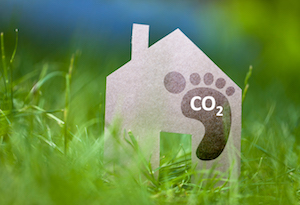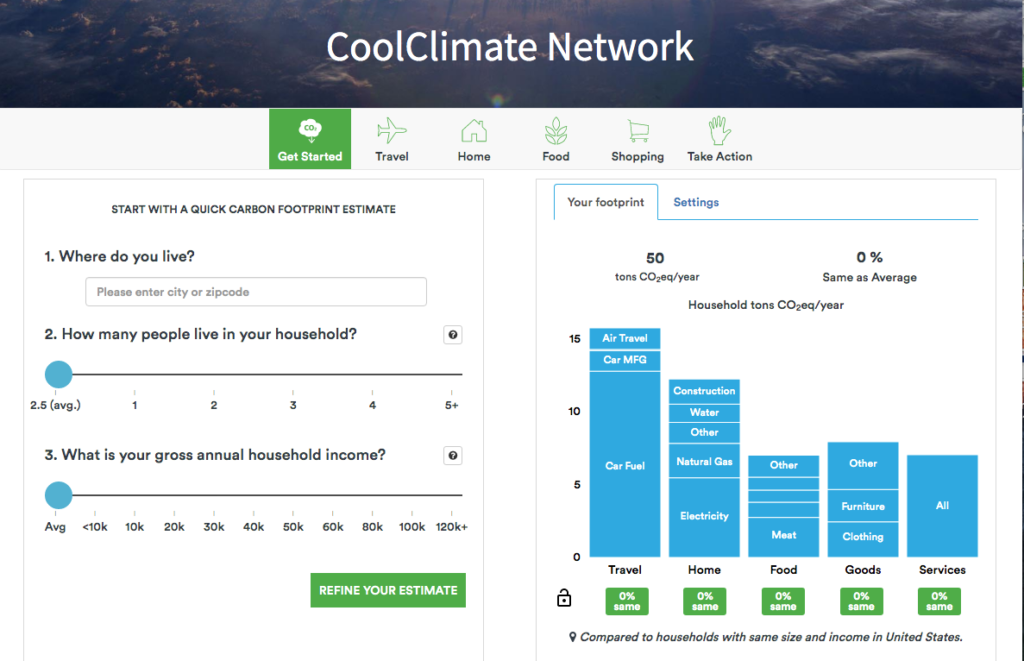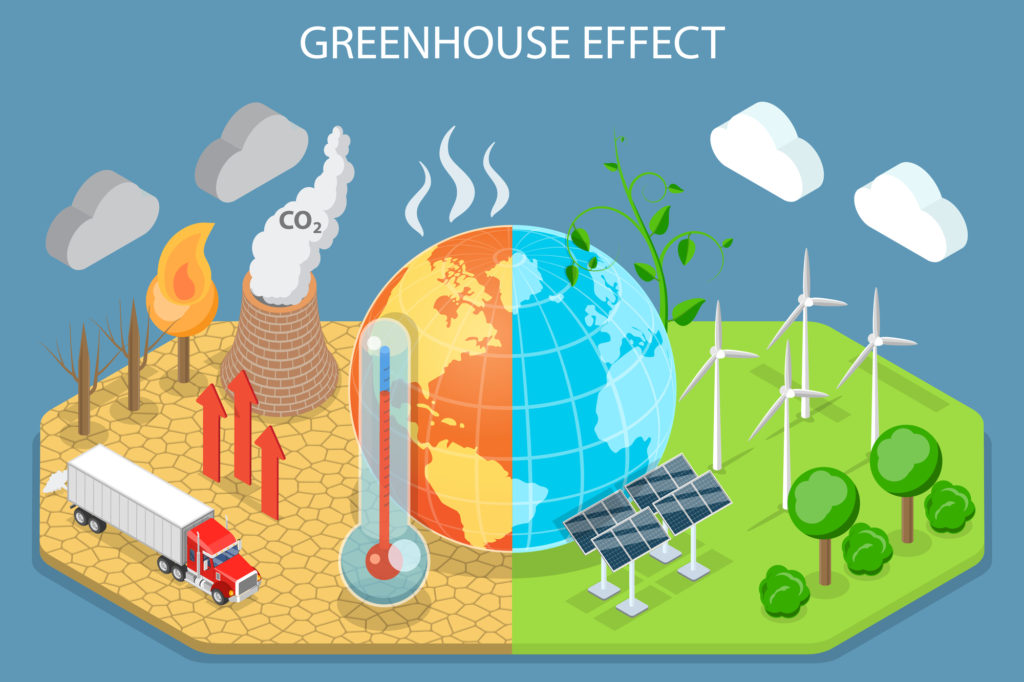Do you have any idea what your “carbon footprint” is? If you’re like most people, the answer is “NO!” … at least not yet.
Read on to find out how to calculate your carbon footprint and what you can do to make it smaller (which everyone needs to do).
WHAT IS YOUR CARBON FOOTPRINT?
Your carbon footprint is how much carbon dioxide (CO2) and other “greenhouse gases” you generate in the course of your daily activities.
You produce greenhouse gas emissions when you do anything that burns oil, coal or natural gas.
For example, driving a gasoline-powered car or truck emits greenhouse gases. Burning oil or gas for home heating or using electricity generated from coal, natural gas, and oil to power your appliances and electronics generates greenhouse gases, too. So does flying on an airplane, taking a cruise, and using a power mower to mow your lawn.
Essentially, any activity that relies on power generated by burning oil, coal, or natural gas creates greenhouse gases and contributes to climate change.
Greenhouse gases can also come from goats, pigs, chicken, and sheep, because animals belch and fart methane, another powerful greenhouse gas. Food that rots in landfills is another source of methane. That’s significant because people end up throwing away about a third of the food they buy.
The quantity of greenhouse gases emitted by your home or your appliances or your vehicle or your lifestyle depends on how much total energy you use. The more efficient your vehicles and appliances and heating systems are, the less you’ll use and the fewer greenhouse gases you’ll emit.
Also, the quantity of greenhouse gases linked to your diet depends on how much meat and dairy you eat and how much food you throw away. Vegetarian diets generally emit far fewer greenhouse gases than diets heavy on meat consumption. The less food you waste, the fewer greenhouse gases your household emits, too.
All of the greenhouses gases linked to your lifestyle make up the sum total of your personal “carbon footprint.”
WHY DO GREENHOUSE GASES MATTER?
Carbon dioxide, methane, and other greenhouse gases generated by all of us are the primary cause of global warming and climate change.
These gases build up in the atmosphere, trapping heat on earth. (You can read about the impacts of climate change here and here). We’re at a point where greenhouse gases are overpowering the atmosphere and the planet is heating up to catastrophic levels.
Climate change is the most serious environmental problem we face.
It’s also one of the most serious threats to our health, economy, and national security.
But as bad as the climate crisis already is, it’s not too late to stop things from getting worse.
We can do our part by shrinking our carbon footprint. That means:
- Use less energy overall
- Switch to clean fuels like solar and wind, and
- Eat less meat and waste less food.
HOW DOES A CARBON FOOTPRINT CALCULATOR HELP?
A Carbon Footprint Calculator helps you figure out how big your footprint is and suggests how you can make it smaller.
In other words, the calculator shows you where you use the most fossil fuels and how you can cut back and use less.
There are many carbon footprint calculators around. I have tried most of them, and I think the best one is the CoolClimate Calculator.
It’s the best because it’s maybe the only that includes food–a huge greenhouse gas emitter–into the calculations. All told, the CoolClimate Calculator takes into account the four main sources of household greenhouse gas emissions:
- Transportation and Travel (which includes the kind(s) of vehicle(s) you drive, how much you drive, whether you use mass transit, etc.)
- Housing (which includes home heating and cooling, lighting, appliances, and other home-based activities that require energy)
- Food (which includes the kind of food you buy as well as how much you throw away)
- Goods, services and leisure (which includes what kind of products you buy, how much stuff you buy, what services you use, and what activities you do on your leisure time).
HOW TO CALCULATE YOUR CARBON FOOTPRINT
1).Go to the CoolClimate website.
2). Have your gas, electricity, water and food bills for a year handy. (You can estimate your monthly or yearly average energy costs. However, I know from personal experience that estimates are usually wrong. For the most accurate picture of how much energy you use and what your emissions are, take the time to calculate what you actually spend and use by looking at your bills.)
3). Complete the very easy-to-follow online calculator. Fill in all the blanks with your own relevant information.
4). Look at your results. Your results will tell you how many tons of greenhouse gas emissions you emit every year. They’re probably somewhere around 20-30 tons.
5). Notice where you generate the most gases. For most people, their homes will be the largest source of greenhouse gas emissions, followed by the kind of vehicle they drive and how much they drive.
6). Look at CoolClimate’s suggestions for ways to reduce your total footprint.
7). Set a goal. This may be the most important step in this process: Set a goal for how much you want to reduce your footprint by, such as 2 tons a year or 10% of your total footprint.
TAKE ACTION TO SHRINK YOUR CARBON FOOTPRINT
Once you calculate your footprint, take action.
Click on the green hand icon that says Take Action on the right side of the navigation bar.
Up will pop a whole host of activities specific to your carbon footprint that show you how much CO2 and money you’ll save when you act.
For example, “Eat a low carbon diet” will cut your carbon footprint by almost 2 tons while saving over $1,000. Switching to a more fuel efficient vehicle, putting solar collectors on your roof, and using a programmable thermostat to reduce your heating and cooling needs will all help you meet your goal.
Now is the time to set your goal for this year: to reduce your carbon footprint by 2, 5 or maybe even 10 tons.
Every year, you can cut your carbon footprint a little bit more. And if you truly can’t get it down to zero, you can compensate for the greenhouse gases you do emit by buying something called a “carbon offset.”
A future post will explain carbon offsets and the best ones to buy–because not all carbon offsets make a difference. The ones I recommend do!
Meanwhile, let us know when you calculate your carbon footprint. Please share with the Big Green Purse Facebook Community and …
No shame, no guilt, no judgement! We’re all in the same boat…we all live on the same planet.
Let’s work together to cut our footprints and help stop climate change now.





















